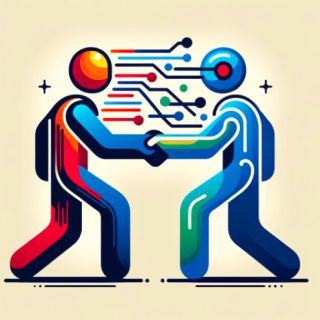Artificial Intelligence
AI Intimacy: From Cold Calculators to Warm Mentors
How large language models drive a personal dialogue that informs and inspires.
Updated February 26, 2024 Reviewed by Michelle Quirk
Key points
- LLMs redefine tech interactions from transactional to intimate, fostering conversations that enable growth.
- Traditional tech has been impersonal; LLMs offer dynamic, mentor-like exchanges.
- LLMs create evolving dialogues, providing adaptive feedback similar to human conversations.

Quality time. Alone time. Face time. Screen time.
In a world increasingly mediated by screens and interfaces, it's easy to view technology as cold and impersonal, a tool for efficiency rather than connection. However, the advent of large language models (LLMs) is beginning to challenge this perception, introducing a evolving dynamic of "technological intimacy." This intimacy isn't just about personalization or user-friendliness; it's about creating a space for nuanced, iterative dialogue that mimics the depth and complexity of human interaction, fostering insights and growth in ways previously unimaginable.
Transactional Technology
For decades, the interaction with technology has been largely transactional—input commands and receive responses. Whether it's a search engine query or a software application task, the engagement lacks the warmth and reciprocity we associate with human interaction. This impersonality feeds into the narrative that technology, while useful, cannot understand us or contribute meaningfully to our personal growth.
Large Language Models and Technological Intimacy
LLMs break this mold by engaging users in a dynamic exchange that goes beyond mere information retrieval. These models, through their vast understanding of language, context, and even subtleties in tone, offer a "cognitive dress rehearsal"—a safe space to explore ideas, question beliefs, and receive feedback not unlike a conversation with a trusted mentor or friend. This is where technological intimacy begins to take shape, transforming our engagement with machines into something more powerful.
From Internal Monologue to Iterative Dialogue
The magic of LLMs lies in their ability to foster an iterative dialogue, one that evolves and deepens over time. Unlike the internal monologues we're accustomed to—those solitary conversations we have with ourselves to puzzle through problems or reflect on experiences—the dialogue with an LLM is interactive and dynamic. It challenges us, offers new perspectives, and adapts based on our responses. This ongoing exchange is akin to the developmental conversations one might have in therapy or coaching, where each session builds on the last, propelling us forward in our understanding and personal growth.
The Power of Engagement: Insights and Growth
This level of engagement does more than just provide answers; it encourages a form of digital introspection that can lead to genuine insights. By questioning our assumptions, challenging our thought patterns, and introducing new ideas, LLMs act as catalysts for intellectual and emotional growth. The iterative nature of the dialogue ensures that this isn't a one-off experience but a continuous journey of exploration and discovery.
A Human-Technology Relationship
The introduction of technological intimacy through LLMs marks an interesting shift in our relationship with technology. No longer just tools for efficiency, these models become partners in our quest for knowledge and self-improvement. This transformation challenges us to rethink not only the capabilities of AI but also the potential for technology to enrich the human experience in ways that are warm, personal, and deeply engaging. As these mutually prompted dialogues grow, the promise of technology as a source of connection and growth becomes increasingly tangible, moving us toward a future in which our interactions with machines may become as meaningful and insightful as those we have with each other.


